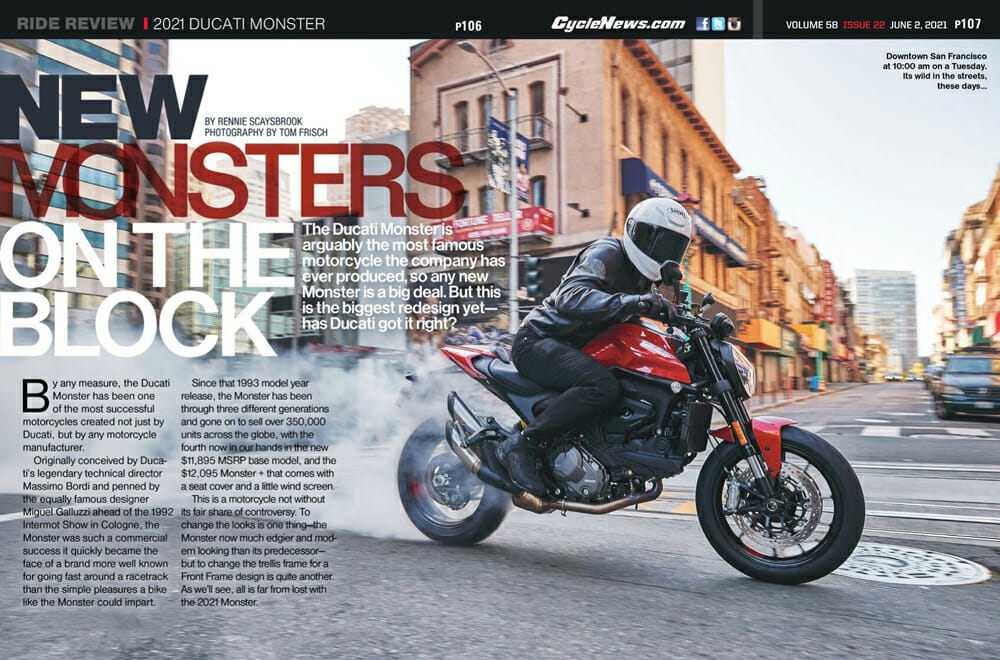Rennie Scaysbrook | June 4, 2021
The Ducati Monster is arguably the most famous motorcycle the company has ever produced, so any new Monster is a big deal. But this is the biggest redesign yet—has Ducati got it right?
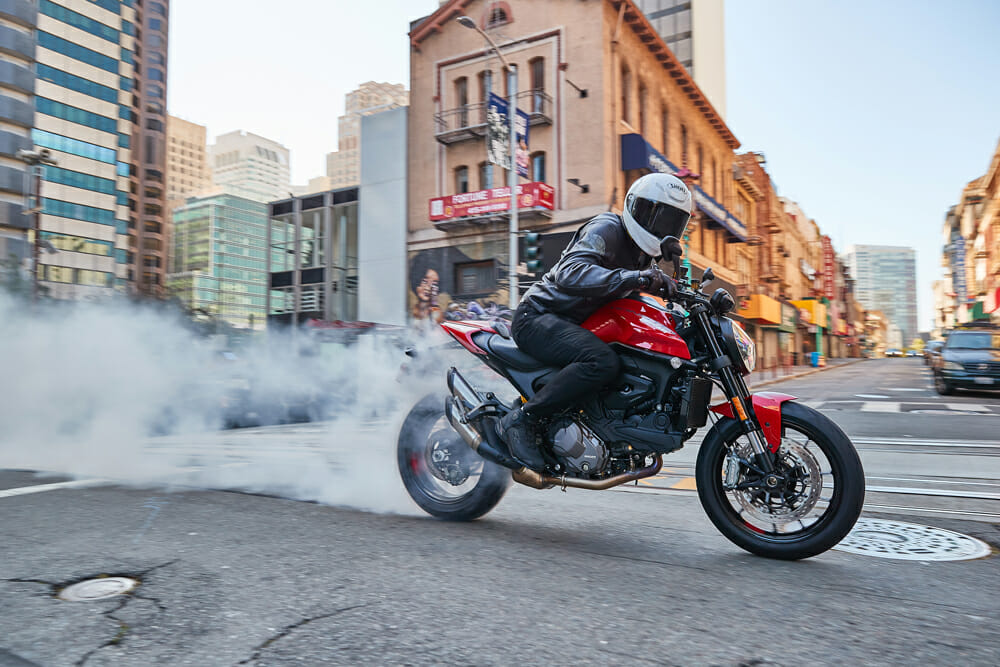 Downtown San Francisco at 10:00 am on a Tuesday. It’s wild in the streets, these days…
Downtown San Francisco at 10:00 am on a Tuesday. It’s wild in the streets, these days…
By Rennie Scaysbrook | Photography by Tom Frisch
By any measure, the Ducati Monster has been one of the most successful motorcycles created not just by Ducati, but by any motorcycle manufacturer.
Originally conceived by Ducati’s legendary technical director Massimo Bordi and penned by the equally famous designer Miguel Galluzzi ahead of the 1992 Intermot Show in Cologne, the Monster was such a commercial success it quickly became the face of a brand more well known for going fast around a racetrack than the simple pleasures a bike like the Monster could impart.
Since that 1993 model year release, the Monster has been through three different generations and gone on to sell over 350,000 units across the globe, with the fourth now in our hands in the new $11,895 MSRP base model, and the $12,095 Monster + that comes with a seat cover and a little windscreen.
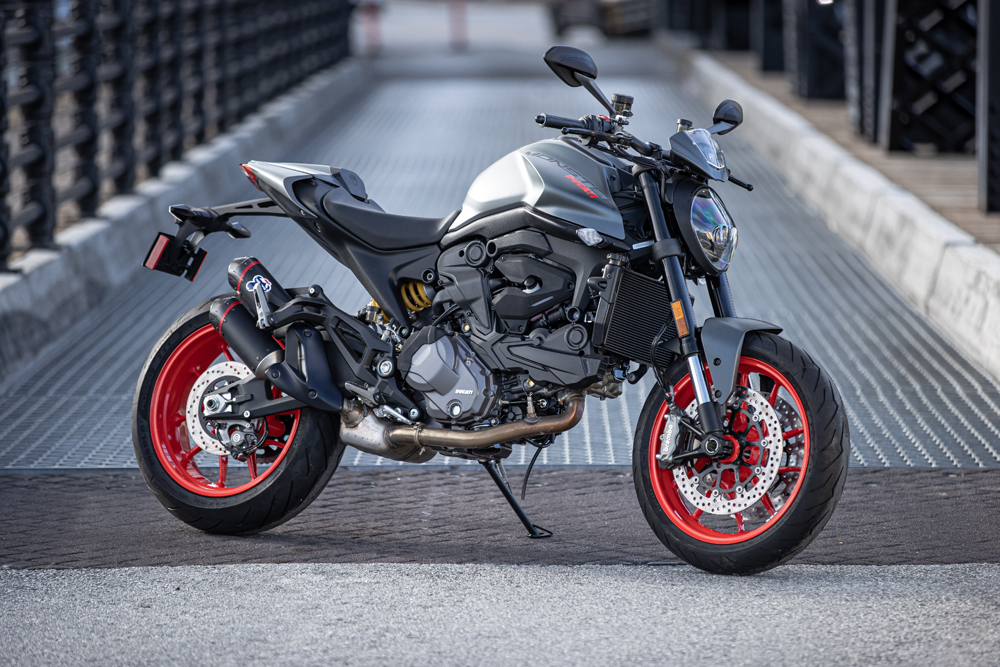 The Aviator Grey is our pick of the colors. The edgy design has come in for lots of criticism from Ducati purists across the globe who love the retro Monster style.
The Aviator Grey is our pick of the colors. The edgy design has come in for lots of criticism from Ducati purists across the globe who love the retro Monster style.
This is a motorcycle not without its fair share of controversy. To change the looks is one thing—the Monster now much edgier and modern looking than its predecessor—but to change the trellis frame for a Front Frame design is quite another. As we’ll see, all is far from lost with the 2021 Monster.
Gone is the Monster 821, with this 937cc model the smallest you can get in the Ducati North American lineup (you can still buy a Monster 695 in other international markets). Those familiar with the Ducati model range will note the 937cc 11° Testastretta motor is found in the Supersport and the Hypermotard, but the Monster’s is a tad different with compression upped from 12.6:1 to 13.3:1. Ducati is claiming 111 horsepower at 9250 rpm—up two horsepower compared to the outgoing 821—with torque up 1.5 lb-ft to 69 lb-ft at 6500 rpm.
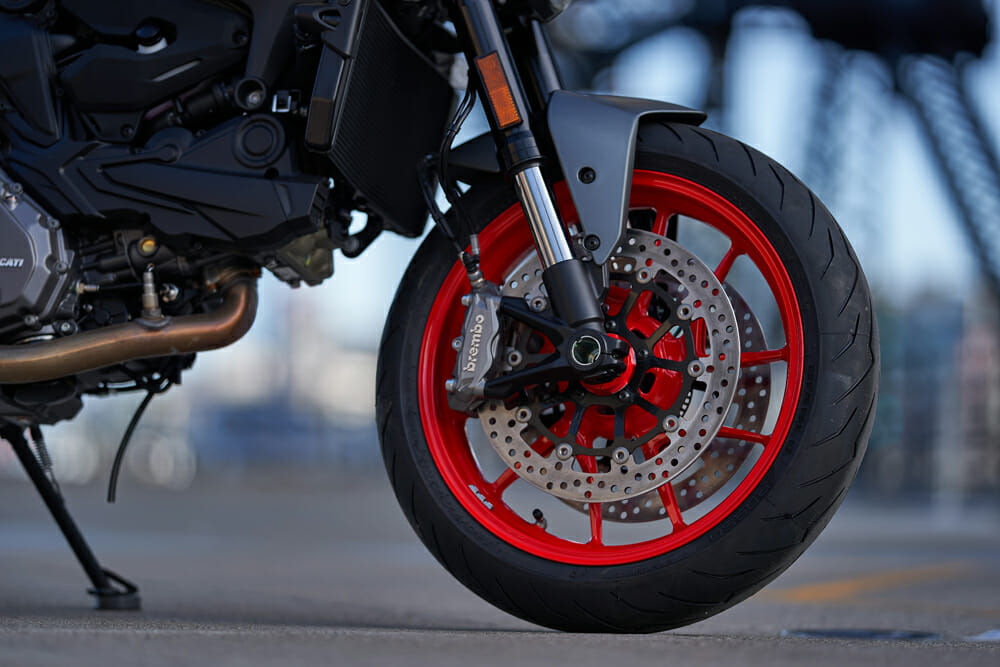 Front suspension is non-adjustable, which isn’t great for a $12K bike. Brembo monoblocs do a fine job of hauling you up from speed.
Front suspension is non-adjustable, which isn’t great for a $12K bike. Brembo monoblocs do a fine job of hauling you up from speed.
But the peak numbers only tell half the story, as the thing you really need on the road, torque, has been boosted substantially from 3000 rpm to past 9000 rpm. It’s especially noticeable between 5-7000 rpm, where there’s close to 20 lb-ft of torque difference across the rev range.
That said, the Monster has a bit of a flat feeling between 3-4000 rpm. This is the point where torque is ramping right up, gaining nearly that 20 lb-ft advantage, and the forward drive seems to come in quite strong once that 4000 rpm point has been met. The new motor may have more overall torque, but it isn’t as smooth as the outgoing 821, which is a price you must pay if you want more go going to the rear tire.
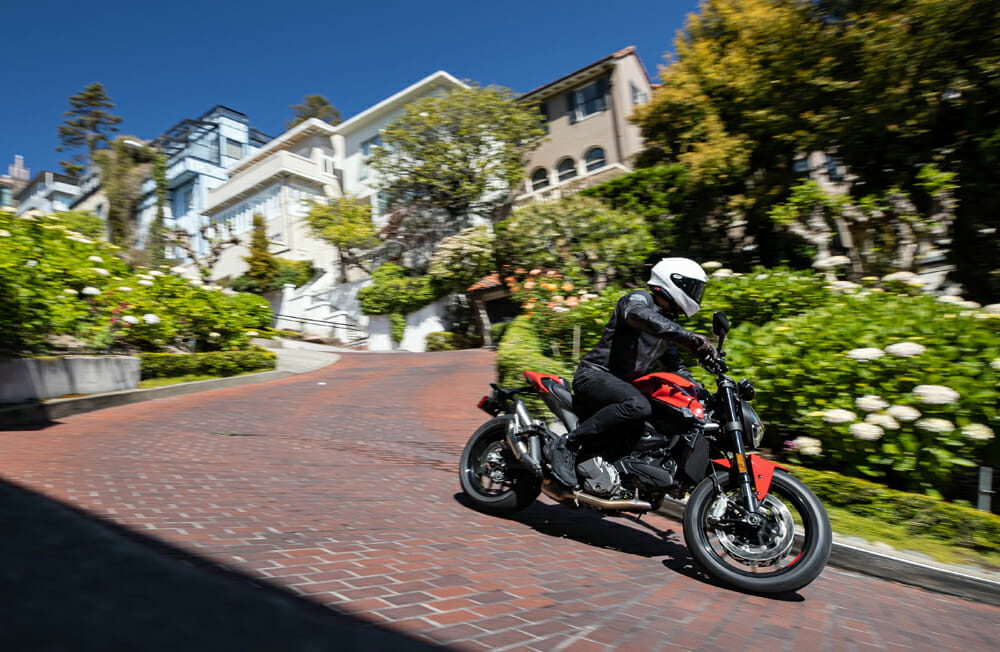 For the price of the Ducati, you couldn’t even buy a window on Lombard Street in San Francisco.
For the price of the Ducati, you couldn’t even buy a window on Lombard Street in San Francisco.
Another factor to think of here is the effect the Euro5 rules have had on the Monster’s motor, and, truth be told, Ducati has done an excellent job of dealing with the dreaded E5 restrictions as best they can—certainly better than several manufacturers I can think of, but won’t shame here.
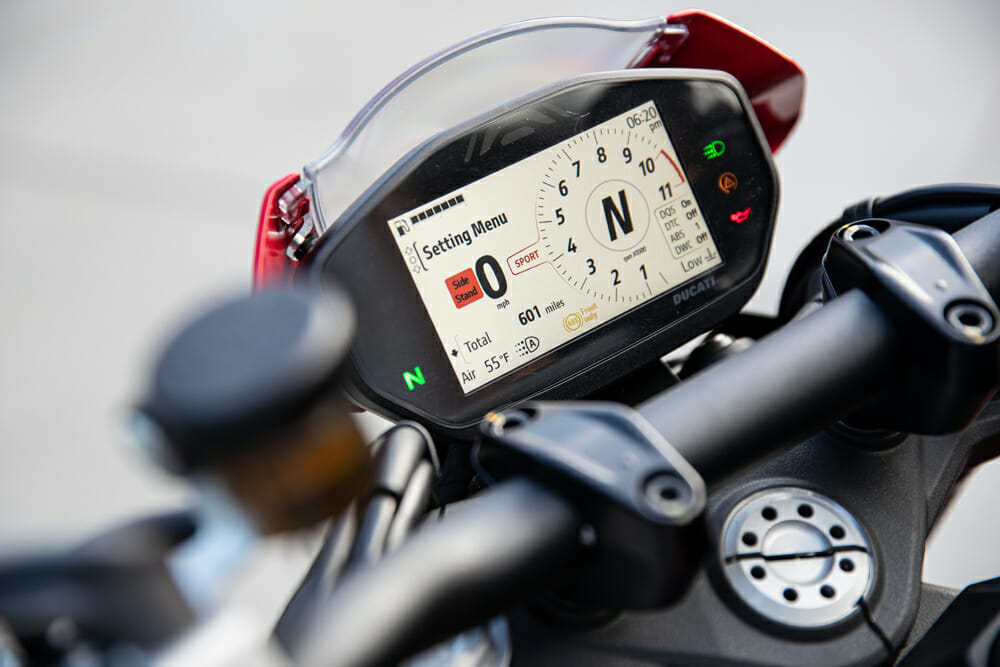 Ducati’s 4.3-inch dash is super easy to navigate and change the plethora of modes at your disposal.
Ducati’s 4.3-inch dash is super easy to navigate and change the plethora of modes at your disposal.
You can affect much of the Monster’s behavior via the adjustable power modes, of which you get three levels. These will at least give new riders the chance to work up to the full 111 horsepower if they aren’t quite ready yet, and you’ve also got a plethora of electronics to play with. There are basic preset modes in Sport, Touring and Urban, all three of which you can go into and adjust the individual parameters. The Monster’s IMU mitigates the eight-stage traction control, three-stage Cornering ABS, and four-stage wheelie control, and it also dictates the cut time for the quickshifter. If you’re on the side of the tire and shifting gears, the cut time will be quicker to reduce the chance of upsetting the chassis balance. Conversely, it’ll be a touch longer if you’re bolt upright. There’s even launch control on the Monster. Not really sure why you need that. I’ll trade that any day for cruise control, which is sadly missing from the Monster’s electronic arsenal.
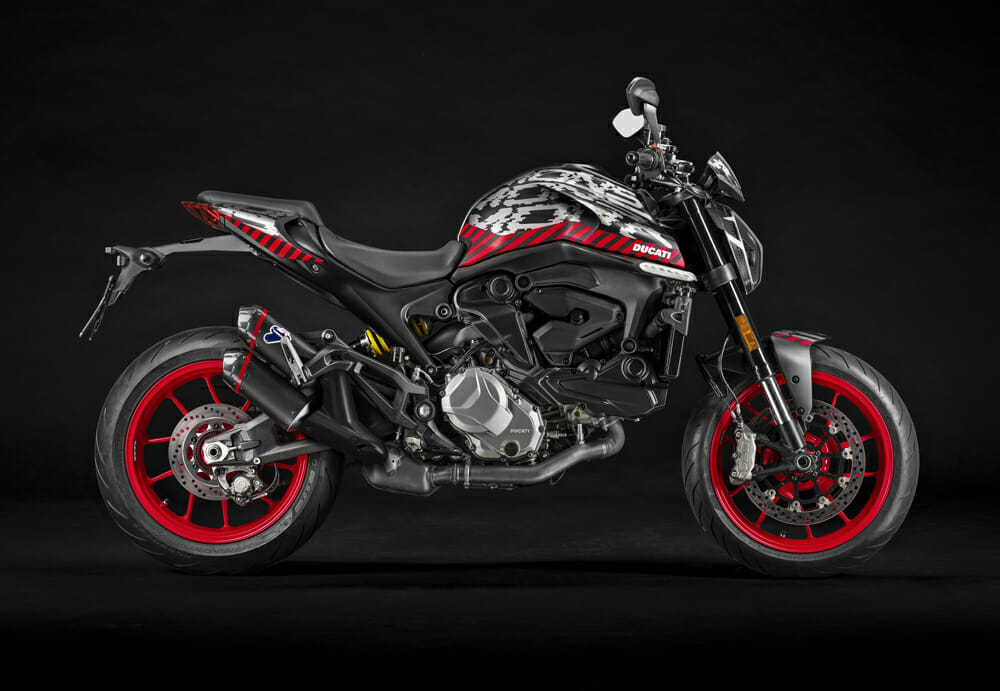 Ducati’s trend, started with the original Scrambler, of making interchangeable bodywork parts is now commonplace on many models. The Monster gets two graphics styles—Pixel kit (pictured) and GP Kit, each available in Ducati Red, Aviator Grey and Dark Stealth.
Ducati’s trend, started with the original Scrambler, of making interchangeable bodywork parts is now commonplace on many models. The Monster gets two graphics styles—Pixel kit (pictured) and GP Kit, each available in Ducati Red, Aviator Grey and Dark Stealth.
A nice feature is when you go to change the settings, the 4.3-inch dash gives you a little image of the bike’s part you’re altering. For example, if you’re adjusting the traction control, the bike’s rear wheel will be lit up in red. Changing the wheelie control? The front wheel gets lit up. So easy, even a monkey like me can figure it out.
This latest line in the Monster saga has seen Ducati engineers do away with the playbook they held so dear to their hearts in the steel trellis frame, which has now been replaced by the front frame design that came to market on the first Panigale V4. This, combined with sundry lightening practices in the swingarm, engine, wheels and the GFRP (Glass Fiber Reinforced Polymer) subframe, has seen Ducati lop an outstanding 40 pounds off the dry weight of the motorcycle. Forty pounds is around one and a half 30 blocks of water you’ll get from your local supermarket, and when you consider manufacturers often find it difficult to get even five pounds of weight off the incoming model (especially given the rigors of Euro5 compliance and the extra weight of the required catalytic convertors), it makes Ducati’s feat all the more impressive.
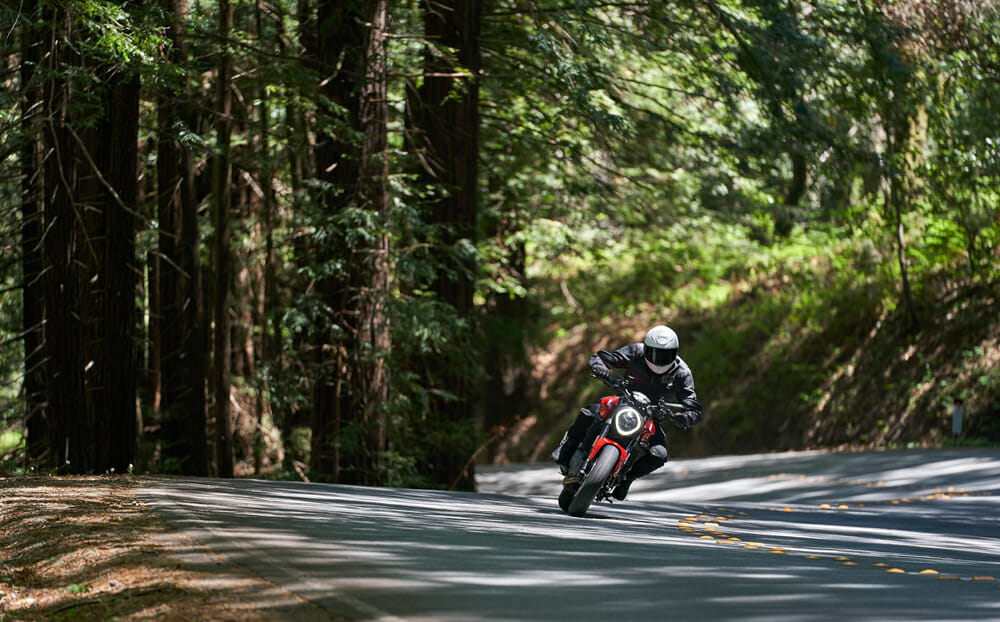 With 40 pounds less than the outgoing Monster, the new model just loves being thrown around in the twisties.
With 40 pounds less than the outgoing Monster, the new model just loves being thrown around in the twisties.
Everything is smaller and narrower with the new Monster, with engineers paying especially close attention to space between the seat and the gas tank. Monsters were traditionally known as having very wide tanks, a bit like a 1990s Suzuki GSX-R. This made it easy to clench with your legs but didn’t give much in the way of letting you move around, especially when the road got twisty, and you needed a more compact and dynamic ride position. That, and it made it harder for shorter riders to put their feet flat on the ground at the lights.
The new tank/seat relationship helps all these points, while giving the chassis a more neutral and unintimidating feel and allowing you to lock your legs in easier while cornering. Ducati is after new riders big time with the new Monster, so anything that can make the machine feel like a natural fit has been explored.
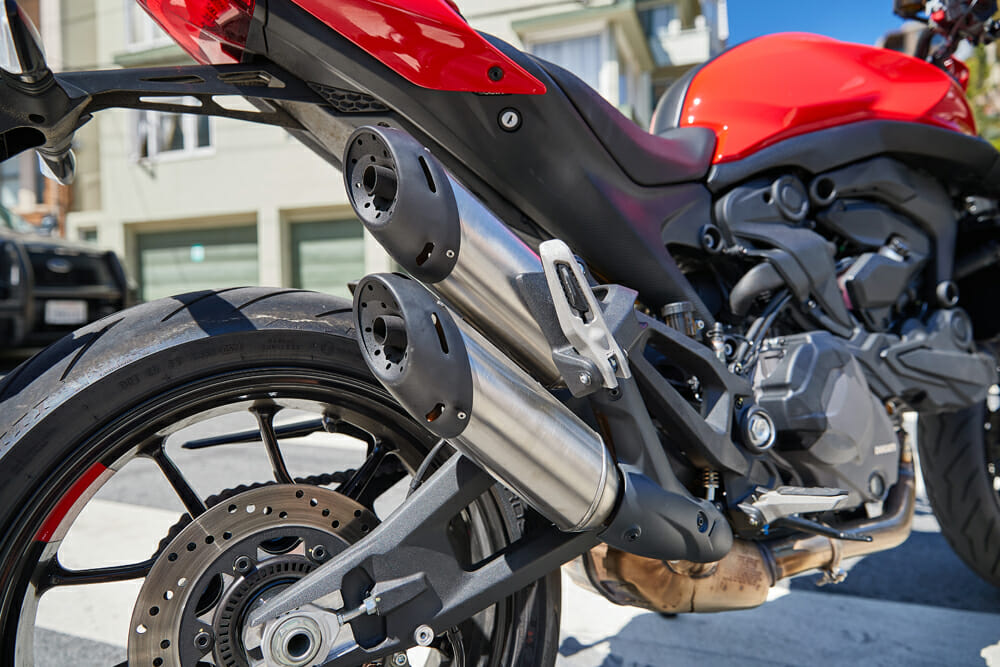 The Monster is slimmed everywhere. The mufflers are now about half the size they were on the 821.
The Monster is slimmed everywhere. The mufflers are now about half the size they were on the 821.
Part of the new rider push is a relaxing on the ergonomics. Aside from the varying seat and suspension heights (see specs) with the handlebar now 2.6 inches closer, and the footpegs 0.4 inches lower and 1.4 inches further back, all helping you maintain a straighter back and taking weight off your wrists. Compared to the outgoing Monster 821 that would get rather uncomfortable after a couple of hours, I knocked out the best part of nine hours in the saddle when testing the ’21 edition in and around San Francisco and hopped off feeling, not brand new, but definitely not as damaged as I could have been, most notably in my aching knees.
An area of interest is the suspension. At the best part of $12K, it is surprising to see the 43mm inverted fork isn’t adjustable at all, while the rear shock only gets preload adjustment. Considering many of the Monster’s class competitors cost less and come with proper suspension adjustment, this is an omission.
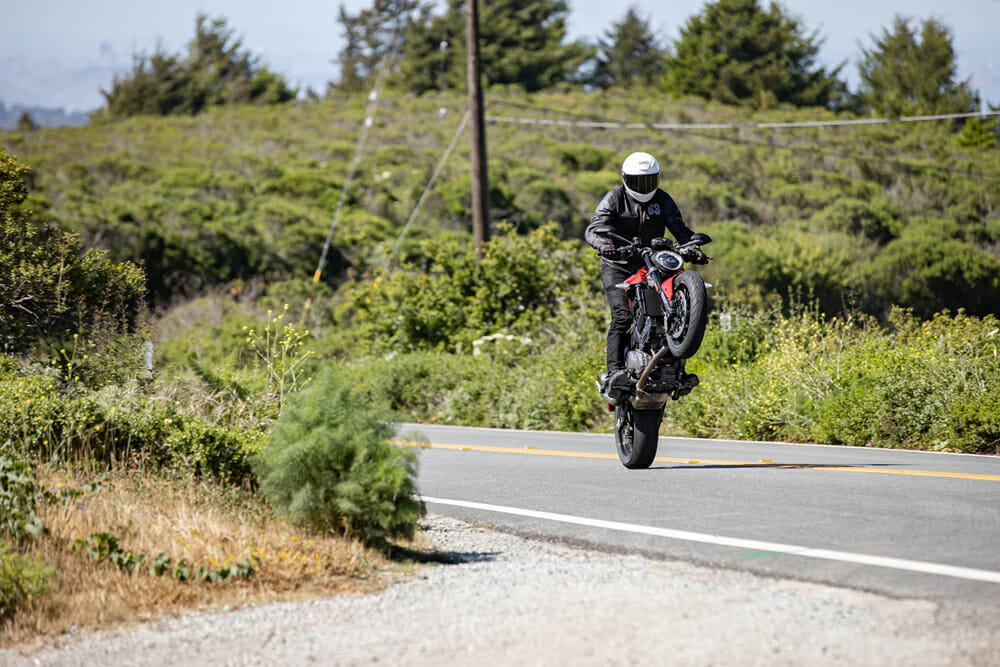 Switching off wheelie control leads to hooliganism. It should be noted in the owner’s manual.
Switching off wheelie control leads to hooliganism. It should be noted in the owner’s manual.
However, there’s a saving grace in that the suspension does its job admirably, especially when you consider when I sat on it (I’m 190 pounds without riding gear), it felt a little on the springy side. In action, the Monster’s non-adjustable front-end performed far better than I expected, soaking up the harsh compression bumps we found in the city just as well as it provided good stability under brakes when we hit the redwood forest twisties.
Good chassis composure, matched by the Jenny Craig weight loss program and a happy little 111 horsepower Testastretta beneath him makes Rennie a happy man. The new ride position makes it easier to really rail corners on your favorite backroad, and the motorcycle changes direction quicker and with more stability that before. And given there’s good braking power and feel via the Brembo master-cylinder and four-piston monobloc caliper setup fitted with Bosch Cornering ABS, the new Monster is an absolute delight in the twisties.
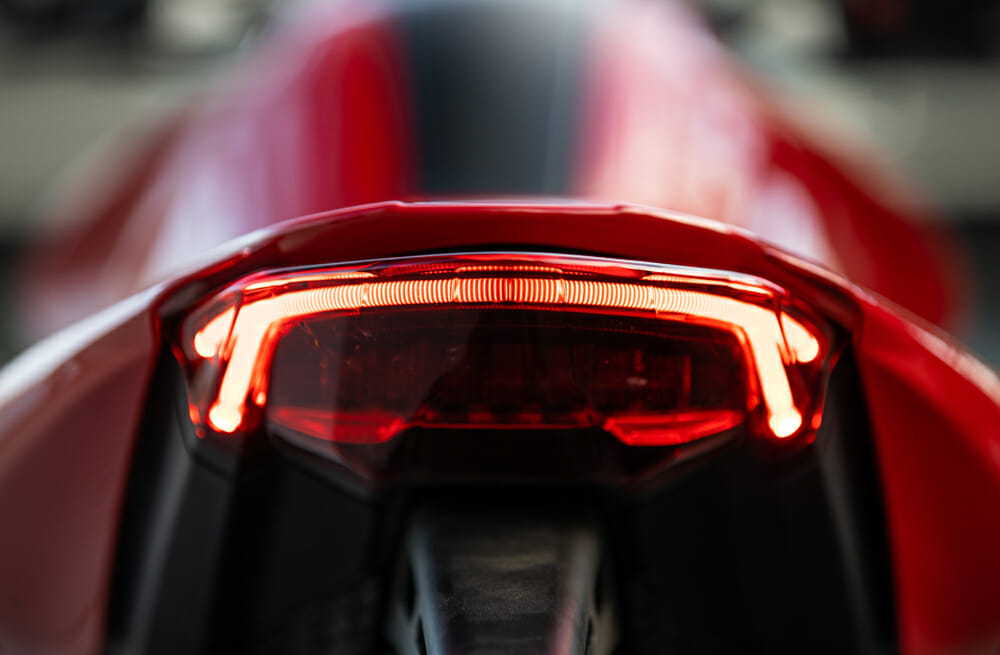 Tidy-looking back end if we do say so, especially with the seat cover.
Tidy-looking back end if we do say so, especially with the seat cover.
Ducati’s done well to make the Monster’s ride engaging for experienced riders while catering to the real market of new riders. Newbies will love how easy this thing is to maneuver at low speed—Ducati has increased the lock-to-lock steering angle 11 degrees to help out in this regard—while riders with more miles under the wheels will take a few jollies out of how peppy the motor is once 5000 rpm is reached and the wheelie control has been switched off.
I seem to be one of the few riders I’ve spoken to that liked the look of the new Monster, so many of my colleagues comparing its looks to a Yamaha MT-09. Given the massive LED headlight and Daytime Running Light (DRL), the sharp tail and redesigned tank, I think it looks nothing of the sort and still retains the Monster look, albeit modernized.
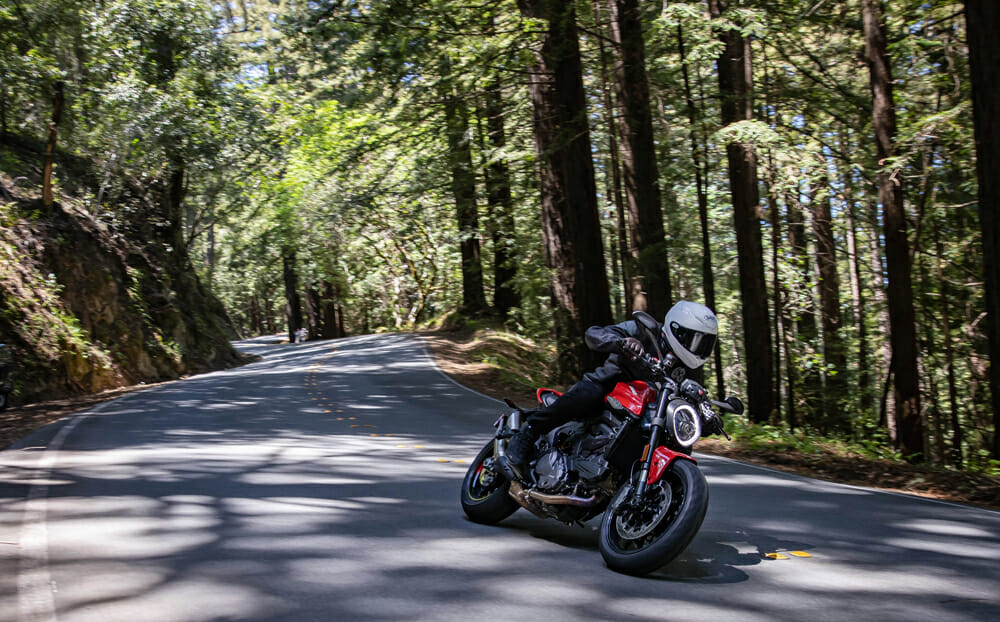
There’s a lot of plastic on the Monster and Ducati could have done better to hide the masses of wires/lines that come with a new bike, especially the exposed lines leading to the rear brake. It’s a small price to pay, but I’ve got to be picky, especially given this bike will cost you more than $12K out the door.
Still, the ride on the 2021 Ducti Monster is a very good one, better than you’d think given the spec of the suspension, which is just as well because if it wasn’t, there’d be all hell to pay from the throngs of Ducatisti across the globe. CN
VIDEO | Ducati Revamps The Iconic Monster for 2021
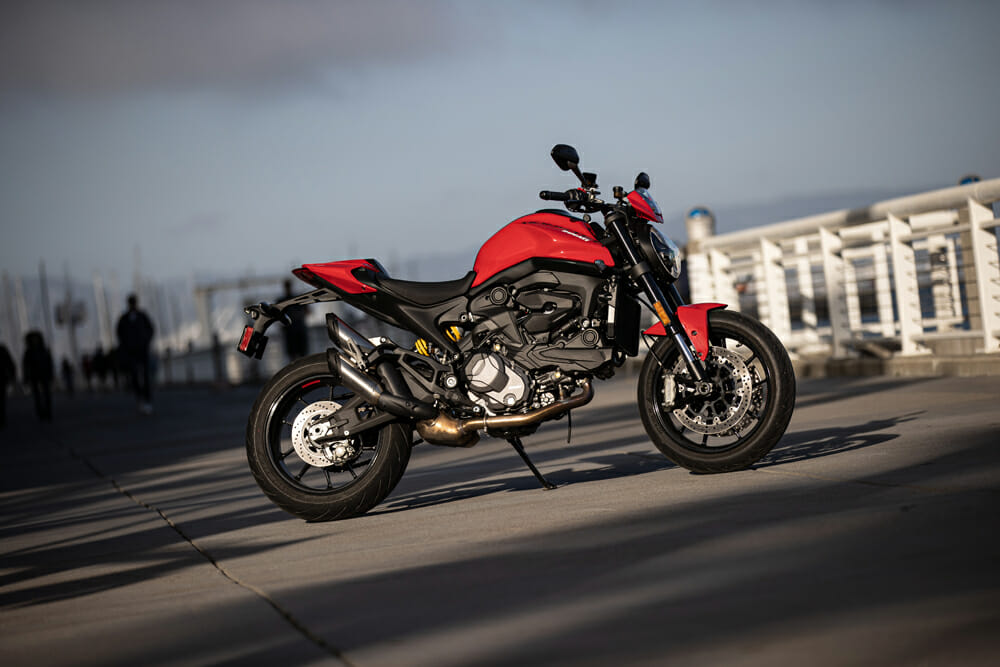
2021 Ducati Monster Specifications
| MSRP: |
$11,895 (base) |
| Engine: |
Testastretta 11° L-twin, 4-stroke |
| Drivetrain: |
4-valves per cylinder, Desmodromic |
| Displacement: |
937cc |
| Bore x stroke: |
94 x 67.5mm |
| Cooling System: |
Liquid |
| Fueling System: |
EFI, 53mm throttle bodies, ride-by-wire throttle, fixed-length intake |
| Compression ratio: |
13.3:1 |
| Power (claimed): |
111 hp at 9250 rpm |
| Torque (claimed): |
69 lb-ft at 6500 rpm |
| Exhaust: |
2-2 |
| Transmission: |
6-speed with bi-directional Quick Shift System |
| Clutch: |
Wet, multi-plate, slipper type |
| Electronics: |
Riding Modes, Power Modes, Cornering ABS, Ducati Traction Control, Ducati Wheelie Control, Daytime Running Light, Ducati Quick Shift, Ducati Power Launch, 4.3” TFT color display, Full LED headlight and lighting system, self-canceling turn indicators, USB power socket |
| Chassis: |
Aluminum front frame |
| Front suspension: |
43mm KYB fork, non-adjustable fork |
| Rear suspension: |
KYB Monoshock, preload adjustable |
| Front brake: |
Dual 320mm semi-floating discs, radially mounted Brembo M4.32 monobloc 4-piston calipers, radial master-cylinder, Cornering ABS |
| Rear brake: |
245mm disc, single-piston caliper, Cornering ABS |
| Front tire: |
Pirelli Diablo Rosso III 120/70 ZR17 in. |
| Rear tire: |
Pirelli Diablo Rosso III 180/55 ZR17 in. |
| Wheelbase: |
58 in. |
| Seat height: |
32.3 in. |
| Fuel capacity: |
3.7 gal. |
| Weight (curb, claimed): |
414 lbs. |
| Colors: |
Ducati Red, Aviator Grey, Dark Stealth |
